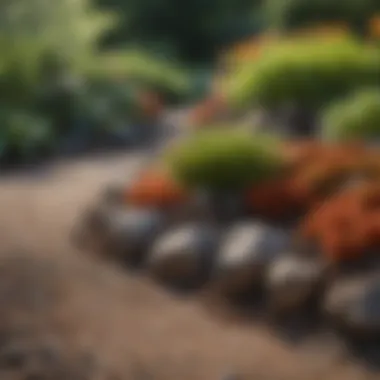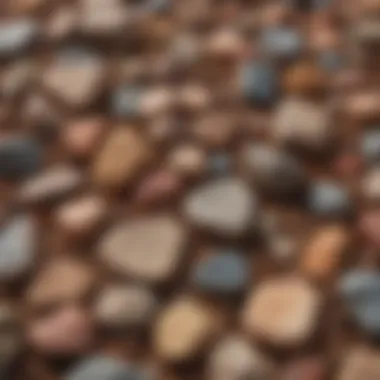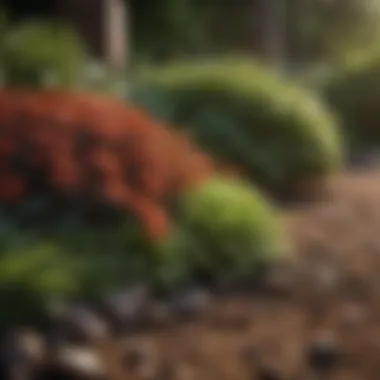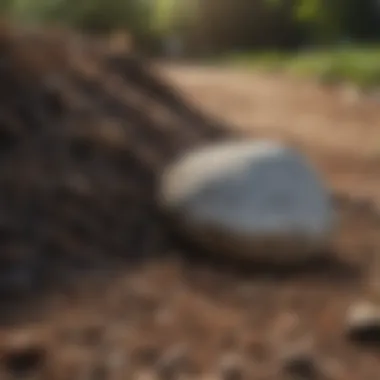Rock vs Mulch: A Comprehensive Landscaping Comparison


Intro
Choosing the right landscaping material is a pivotal decision for any homeowner or gardening enthusiast. The choice between rock and mulch is often influenced by various factors, including aesthetics, maintenance, and environmental implications. Both materials offer unique benefits and downsides that can affect their performance in garden design. Therefore, understanding the core characteristics of rock and mulch is essential for making an informed decision.
The use of rocks in landscaping can create a polished, sophisticated appearance. Rocks serve as excellent ground cover and can also offer drainage benefits in certain garden layouts. On the other hand, mulch provides a more organic, lush look and is often favored for its capability to improve soil quality, conserve moisture, and suppress weed growth.
In this article, we will delve into the characteristics of rock and mulch. We will explore their respective benefits and disadvantages, as well as their suitability for different gardening scenarios. By examining aspects such as aesthetics, maintenance requirements, environmental impact, and costs, readers will gain a more profound insight into which option aligns best with their landscaping goals. This comprehensive comparison aims to empower homeowners and gardening enthusiasts to make a savvy, environmentally-friendly decision.
Intro to Landscaping Materials
Landscaping materials significantly affect the aesthetic and functional aspects of outdoor spaces. Choosing the right material is essential for homeowners aiming to create visually appealing environments while ensuring practicality and sustainability. In this article, we will examine the materials often used in landscaping, particularly rock and mulch. Understanding their unique properties will help inform decision-making for any landscape project.
The Role of Landscaping in Home Design
Landscaping serves a vital role in home design by enhancing aesthetic appeal and increasing property value. A well-planned landscape can transform a simple exterior into a harmonious extension of the home. It adds a sense of order and beauty that complements architectural features and adapts to the natural environment. Attractive landscaping invites visitors and creates a welcoming atmosphere. Furthermore, it can contribute to energy efficiency by providing shade and reducing temperatures around the home.
Pitfalls exist when ignoring landscape design. Unplanned spaces can lead to inefficient use of resources or even safety hazards. Proper use of landscaping materials can help achieve a balance between beauty and functionality. Therefore, understanding different options, such as rock and mulch, will guide homeowners to make informed decisions, fitting their style and practical needs.
Importance of Choosing the Right Material
The choice of landscaping material carries implications for maintenance, longevity, and overall environmental impact. Different materials will react diversely to climate conditions and local ecosystems. Selecting rock or mulch can influence water drainage, soil health, and insect activity in the garden.
Choosing appropriate materials is also about aesthetics. Various rocks and mulches can enhance color and texture. Homeowners should consider their specific preferences and the style of their abode. It is often beneficial to think about the intended purpose of the landscaped area. For instance, if a family desires a garden that thrives with plants, mulch may serve better. Conversely, if water conservation and reduced maintenance are priorities, rock may be the more effective choice.
In summary, understanding landscaping materials, their roles, and their strategic use will lead to a more rewarding garden or yard project.
Overview of Rock Landscaping
Rock landscaping has emerged as a popular choice among homeowners and gardeners for various reasons. It provides a unique aesthetic that can complement a wide range of architectural styles and garden designs. Using rocks as a primary landscaping material offers both visual appeal and practical benefits, making it an important consideration when planning your outdoor space.
Choosing rock landscaping can enhance the overall structure of a landscape, providing various textures and forms that contribute to visual interest. Additionally, the durability of many types of rocks means that they can withstand harsh weather conditions and require less maintenance than other options. However, understanding the various types of rocks and their specific characteristics is key to making an informed decision.
Types of Rocks Used in Landscaping
Gravel
Gravel is one of the most versatile materials in landscaping. Its primary characteristic lies in its ability to provide excellent drainage. This feature makes it a beneficial choice for pathways, driveways, and decorative beds. Gravel comes in a variety of sizes and colors, allowing for customization to match existing architecture or plant life.
A unique feature of gravel is its ease of installation. It can be spread over any well-prepared base, often requiring minimal tools or preparation. On the downside, gravel can shift over time, posing potential accessibility issues.
Flagstone
Flagstone is appreciated for its aesthetic and physical properties. This flat stone is often used for patios, walkways, and retaining walls. Its key characteristic is its natural beauty, available in a spectrum of colors and textures. This stone can easily blend into natural landscapes or stand out as a stunning feature.
Flagstone's unique feature lies in its ability to create a stable surface while maintaining a rustic charm, which makes it a linear and attractive choice. However, the cost and labor associated with cutting and laying flagstone can be considered a disadvantage compared to simpler materials.
Boulders
Boulders serve as prominent focal points in any landscape design. Their key characteristic is their size and grandeur, which can create dramatic effects in any garden. Boulders can also provide natural structure and elevation in a landscape while being functional as seating or as part of a retaining wall.
The unique feature of boulders is their permanence. They add weight to the landscape and are rarely displaced by weather or traffic. However, the challenges with placement and transportation can increase overall installation costs and complexity.
Aesthetic Appeal of Rock Landscapes
Rock landscapes offer a diverse range of visual textures and forms. The colors and shapes of rocks can add depth and contrast to outdoor spaces, making them visually stimulating. The natural appearance of rocks can integrate seamlessly with plant life, creating a harmonious blend between the organic and the mineral.
Benefits of Rock Landscaping
Durability


The durability of rock landscaping is one of the primary benefits. Rocks do not decompose or wear down over time, which means they can last for years without needing replacement. This quality makes them a highly effective investment for long-term landscaping solutions.
Low Maintenance
Another notable aspect is the low maintenance required for rock landscaping. Unlike lawns or gardens that need regular watering, pruning, and fertilizing, rocks remain intact, requiring only occasional cleaning or repositioning. This factor is especially attractive to busy homeowners or those who wish to minimize their landscaping workload.
Weed Control
Weed control is a significant benefit when using rocks. Because they do not allow for soil accumulation, fewer weeds can sprout in rock-covered areas. This can lead to a more pristine appearance while reducing the labor involved in pulling or applying herbicides.
Disadvantages of Rock Landscaping
Heat Retention
One of the downsides of rock landscaping is its heat retention. Rocks absorb heat during the day, which can create a hotter environment, potentially leading to discomfort for people and plants. Understanding this characteristic is crucial, especially in warmer climates.
Limited Plant Growth
Rock landscapes can limit plant growth more than traditional landscaping options. With their permanence and hard surface, fewer plants can thrive among the rocks. Options for integrating plant life need careful consideration to ensure a visually appealing and functional landscape.
Installation Costs
Finally, installation costs associated with rock landscaping can be considerable. The need for heavy machinery and skilled labor can increase upfront expenses. Furthermore, depending on the types of rock you choose, prices can vary widely, affecting the overall investment.
Overview of Mulch Landscaping
Mulch landscaping is an often overlooked yet crucial element in creating sustainable and visually appealing outdoor spaces. It involves the use of various organic or inorganic materials spread around plants and garden beds. The purpose of mulch goes beyond mere aesthetics; it plays a significant role in enhancing soil health and conserving moisture. This section explores key elements about mulch landscaping, highlighting its benefits and considerations.
Types of Mulch Available
Organic Mulch
Organic mulch consists of natural materials that decompose over time, enriching the soil. Common types include wood chips, bark, straw, and leaves. This type of mulch is popular because it improves soil health by adding nutrients back into the ground as it breaks down. A unique feature of organic mulch is its capacity to retain moisture while allowing air circulation. However, it does require periodic replenishment as it decomposes over time.
Inorganic Mulch
Inorganic mulch includes materials like gravel, stones, and plastic. While it does not provide nutrients to the soil, it serves other purposes such as weed suppression and aesthetic appeal. A key characteristic of inorganic mulch is its durability; it can last for many years without needing replacement. However, it does not contribute to soil health, and its application can sometimes result in heat build-up, affecting nearby plant life.
Aesthetic Appeal of Mulch Landscapes
Mulch can dramatically enhance the visual appeal of landscaping. It creates a clean and organized look around plants and garden beds. Color and texture can vary widely, allowing for creative design choices. For instance, dark-colored mulch can provide a stark contrast to vibrant flowers, making them stand out more. Overall, mulch offers various design options while maintaining functionality.
Benefits of Mulch Landscaping
Soil Health
Mulch improves soil health significantly by preventing erosion and promoting nutrient retention. This natural barrier protects the soil from extreme temperatures, leading to healthier plant growth. A beneficial aspect of maintaining soil health is that it also fosters a more sustainable gardening environment. Using organic mulch contributes directly to enhancing the ecosystem.
Moisture Retention
Moisture retention is a critical benefit of using mulch. It minimizes evaporation from the soil surface, ensuring that gardens remain hydrated during dry spells. This characteristic makes mulch an excellent choice for regions with inconsistent rainfall. The result is reduced watering needs, which can result in cost savings over time.
Erosion Prevention
Erosion can be a significant issue in landscaping, particularly on sloped areas. Mulch acts as a protective layer, reducing the impact of rain and wind on the soil. This benefit helps maintain the integrity of garden beds and promotes better growth conditions for plants. The use of mulch can, therefore, be a strategic choice for homeowners looking to prevent soil displacement.
Disadvantages of Mulch Landscaping
Decomposition


One of the main disadvantages of organic mulch is its tendency to decompose. As it breaks down, it may require replacement or replenishment to maintain its effectiveness. While this process enriches the soil, it can also lead to added maintenance inconvenience.
Pest Attraction
Organic mulch can attract unwanted pests such as insects or rodents. These creatures may find it a suitable environment for nesting. It is essential for homeowners to monitor their gardens and take appropriate measures if pest issues arise.
Frequent Replacement
Lastly, the need for frequent replacement is a notable downside for many types of mulch, especially organic options. The natural decomposition process means that organic mulch will eventually break down completely, requiring homeowners to invest time and resources to keep their landscapes looking pristine. This could detract from the overall convenience of landscaping with mulch.
Environmental Considerations
When considering landscaping materials, environmental considerations play a crucial role in ensuring the long-term health of the ecosystem and the sustainability of gardening practices. This section delves into how the choices between rock and mulch landscaping impact both local environments and broader ecological systems. Understanding these implications allows homeowners and landscape enthusiasts to make informed, responsible choices that align with their values, aesthetics, and practical needs.
Rock Landscaping and Sustainability
Rock landscaping offers durability and a unique visual appeal. However, the sustainability of rock requires scrutiny of its sourcing and use. Natural rock typically comes from quarries. This process can result in habitat destruction, soil erosion, and significant energy consumption in transport. Thus, when selecting natural stone, it is vital to consider:
- Source of the stone: locally sourced rock has a lower environmental impact compared to distant quarries.
- Energy output: heavy machinery used in quarrying contributes to greenhouse gas emissions.
From an ecological standpoint, rock landscapes tend to heat up under direct sun, which can dramatically change local microclimates and affect surrounding plant life. Native plants often struggle to thrive in such conditions. Yet, when implemented thoughtfully, rock landscaping can still benefit ecosystems by creating favorable habitats for certain species like reptiles and insects. Careful plant selection can mitigate some negative impacts.
Regular maintenance is essential. Routine cleaning of rock landscapes aids in preventing waste accumulation, which can harm wildlife. Thoughtful arrangements that incorporate native flora can help restore balance to these environments. Overall, while rocks can offer longevity, considerations around sourcing and ecological balance are paramount.
Mulch Landscaping and Ecological Impact
In contrast, mulch landscaping tends to prioritize ecological health, offering benefits that promote soil vitality and support biodiversity. Organic mulch, such as wood chips or bark, breaks down over time, enhancing soil quality and promoting healthy plant growth.
The ecological impact of mulch comes from several factors:
- Soil enrichment: As mulch decomposes, it improves soil structure and nutrient content, fostering a thriving ecosystem within the soil.
- Moisture retention: Mulch helps retain moisture, reducing the need for irrigation, which is beneficial in dry climates.
- Erosion control: It effectively prevents soil erosion by shielding the soil from heavy rain and wind.
However, it’s essential to be aware of potential downsides. For instance, some organic mulches can attract pests if not managed correctly. Regular mulching is needed to maintain its effectiveness and prevent the spread of pests. Utilizing a mix of organic and inorganic mulches can provide a balanced approach.
In essence, mulch landscaping aligns closely with sustainable gardening practices. It encourages biodiversity, promotes soil health, and can significantly lower water usage. Homeowners should consider their specific environments and select their materials based on how well they will integrate into local ecosystems.
"Choosing the right landscaping material not only affects aesthetics but also influences local ecology and sustainability."
Understanding these environmental considerations is paramount for any landscaping project, ensuring that each choice supports not just personal goals but also communal and planetary health.
Cost Analysis
Cost is a pivotal consideration when selecting between rock and mulch for landscaping. Both materials come with their own price points and ongoing expenses that can impact your overall landscaping budget. Understanding these costs is essential for homeowners who aim to balance aesthetics with practicality. This section will evaluate the financial aspects associated with both rock and mulch, ensuring that readers have a comprehensive picture to aid in their decision-making process.
Initial Costs of Rock vs. Mulch
When assessing initial costs, rock landscaping typically demands a higher upfront investment compared to mulch. This can partly be attributed to the purchase price of the material itself and the labor involved in installation. Rocks like flagstone or boulders require specialized tools and expertise for proper placement.
On the other hand, mulch tends to be less expensive, readily available, and easier to install, making it a more appealing option for budget-conscious homeowners. Organic mulches, such as shredded bark or wood chips, are generally more affordable than inorganic options like rubber mulch. Here are some specific points to consider regarding initial costs:
- Material Cost: The price of rock varies depending on the type chosen, whereas mulch prices can fluctuate based on the source and material type.
- Transportation: The weight and bulkiness of rocks may lead to higher shipping costs, particularly if the source is distant.
- Installation Fees: Labor costs for a rock installation can exceed those for mulch due to the complexity of layouts and heavy lift requirements.
Choosing the right material right at the onset can set the tone for your landscaping endeavors.
Long-term Financial Implications
The long-term financial implications of rock vs. mulch are largely influenced by maintenance requirements and longevity. Rock landscapes usually entail less frequent upkeep compared to mulch, which often decomposes and must be replenished periodically. This can lead to significant savings over time.
- Durability: Rocks maintain their form and do not degrade like organic mulches. This means that after the initial investment, there are minimal costs associated with replacing or refilling.
- Maintenance Costs: While rock doesn't need replacing, it does require some occasional upkeep, such as removing debris or weeds. In contrast, organic mulch will demand regular replenishment, which can add up over the years.
- Water Savings: Mulch can help retain soil moisture, reducing irrigation costs. However, rocks do not offer a moisture-retaining benefit. Deciding on landscape irrigation strategies will impact costs in the long run.


In summary, initial costs may favor mulch, but when considering the life cycle of the landscaping material, rock often emerges as a financially prudent choice. Evaluating both immediate and long-term expenses is essential to making an informed decision that aligns with both financial and landscaping goals.
Maintenance Requirements
In the realm of landscaping, maintenance requirements play a considerable role in determining the practicality and success of a project. Homeowners must account for the upkeep necessary for maintaining a landscaped area. Both rock and mulch have distinct maintenance profiles.
Understanding these requirements is crucial for any homeowner or gardening enthusiast. It helps in planning time, budget allocation, and overall satisfaction with the landscaping result. Moreover, evaluating these factors can significantly influence the long-term viability and aesthetic appeal of a garden space.
Regular Maintenance for Rock Landscapes
Rock landscapes generally require less frequent maintenance compared to other landscaping materials. However, some attention is still needed to ensure the landscape remains attractive and functional. Here are some key maintenance aspects:
- Weed Management: Though rock landscapes discourage weeds better than mulch, they are not entirely immune. A periodic review and hand-pulling of any visible weeds are necessary.
- Rinsing Off Debris: Over time, dust, dirt, and organic material may accumulate on the rocks. A gentle wash using a hose can help maintain the clean appearance of the stones.
- Preventing Shifting: Heavy rain or erosion can cause rocks to shift. Regularly checking areas where movement might occur and repositioning rocks can keep the layout intact.
- Checking for Gaps: As time passes, gaps may appear between the rocks, allowing weeds to emerge. Keeping an eye on these areas and refilling with smaller stones or gravel can provide a neat look.
Regular Maintenance for Mulch Landscapes
On the other hand, mulch landscapes require a more proactive approach to maintenance. Different types of mulch may require different care, but common maintenance needs include:
- Replacement of Decomposed Mulch: Organic mulch, like wood chips, will decompose. A typical recommendation is to refresh the mulch layer every year to maintain its benefits and aesthetic value.
- Weed Control: Mulch is beneficial for suppressing weeds, but not completely eliminating them. Regular weeding, especially after rain, helps maintain a neat appearance.
- Moisture Monitoring: Mulch helps retain moisture, but it’s still essential to check the soil moisture beneath. Regular watering might be necessary depending on the climate.
- Pest Inspection: Mulch can attract pests like termites, so homeowners should routinely inspect their mulch areas for any signs of infestation.
Regular maintenance is key to ensuring your landscaping thrives, whether you choose rock or mulch. Each option brings its own needs, which can significantly impact the landscaping aesthetics and health over time.
Choosing Between Rock and Mulch
Selecting between rock and mulch for landscaping is crucial. It can influence the aesthetics, functionality, and maintenance of your outdoor spaces. Understanding the nuances of each option can guide homeowners in making informed choices that align with their desires and landscape needs.
Factors Influencing Your Decision
Climate
Climate plays a significant role in the decision-making process. Regions with high temperatures may find rock landscaping more appealing due to its heat resistance and durability. Rocks tend to absorb heat from the sun, leading to warmer soil, which can be beneficial for certain plants. However, in cooler climates, mulch may be a better option. It retains moisture and provides insulation to the soil during colder months. The unique characteristic of different climates is how it shapes the landscape’s overall appeal and functions. For instance, rocky landscapes can create a striking, desert-like aesthetic in arid areas, while mulch supports vibrant gardens in temperate regions.
Soil Type
Soil type is another critical factor. Sandy soils, for example, drain well but may require more frequent watering. In such cases, mulch can help retain moisture. Conversely, heavy clay soils often retain too much water. In these situations, using rocks can improve drainage. The key aspect here is how soil characteristics dictate plant health and water retention, which ultimately affects landscaping choices. Properly understanding soil composition ensures that landscaping methods chosen will support plant growth effectively and enhance the landscape’s overall sustainability.
Plant Choices
The types of plants you wish to grow will also influence whether to choose rock or mulch. For gardens with a lot of flowering plants, mulch is often preferred. It nourishes the soil as it breaks down, promoting healthier plant growth. On the other hand, rock landscaping is ideal for areas with drought-resistant plants or xeriscaping, where less water is needed. The unique feature of plant selection is how it aligns with the chosen landscaping material, allowing homeowners to create cohesive and visually appealing designs. This understanding is essential for optimizing the benefits of each method.
Examples of Successful Landscapes
Numerous examples showcase effective uses of both rock and mulch in landscaping:
- Rock Gardens: Suitable for homes in arid climates, these gardens often incorporate succulents and desert plants. They require little maintenance once established and present a striking appearance.
- Flower Beds with Mulch: In temperate areas, using organic mulch around vibrant flower beds helps retain moisture and enrich the soil, perfect for annual and perennial blooms.
Residents can draw inspiration from local examples and consider how each material reflects their landscaping goals. By analyzing successful projects, homeowners gain practical insight into the aesthetics and maintenance aspects of their choices.
End
In the final analysis of landscaping materials, the significance of understanding the nuances between rock and mulch cannot be overstated. Both options present unique benefits and drawbacks that cater to different aesthetic preferences, maintenance capabilities, and environmental concerns. Homeowners contemplating landscaping decisions must consider how each material aligns with their overarching goals.
Summary of Key Points
- Rock Landscaping:
- Mulch Landscaping:
- Environmental Considerations: Assess sustainability against ecological impact.
- Cost Analysis: Initial and long-term financial implications merit careful review.
- Maintenance Requirements: Regular tasks differ significantly between the two materials.
- Types of Rocks: Variety includes gravel, flagstone, and boulders.
- Benefits: Offers durability, low maintenance, and effective weed control.
- Drawbacks: Issues with heat retention and potential limited plant growth.
- Types of Mulch: Options are organic or inorganic.
- Benefits: Enhances soil health, retains moisture, and prevents erosion.
- Drawbacks: Can decompose, attract pests, and requires frequent replacement.
Final Thoughts on Rock vs. Mulch
Final considerations should extend beyond mere aesthetics or costs. Homeowners must assess their local climate, soil type, and the types of plants they plan to cultivate. The synergy between these components will ultimately dictate the success of the chosen landscaping style. A well-informed choice stands to enhance not only the visual appeal of a property but also contribute positively to the environment.
Choosing between rock and mulch is not simply about preference; it is about understanding the broader impact on the ecosystem and long-term sustainability. Each material brings its own identity and functionality, making it crucial for individuals to evaluate their specific needs and circumstances. This evaluation will ensure that their landscaping decisions are well-rounded, purposeful, and aligned with their personal and ecological values.















